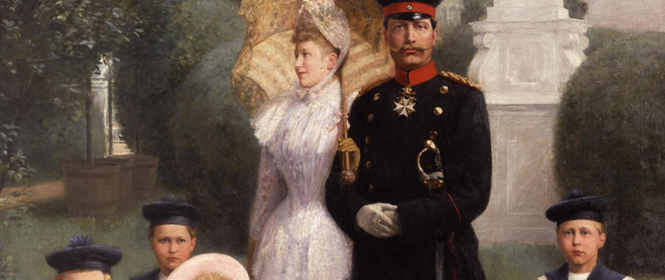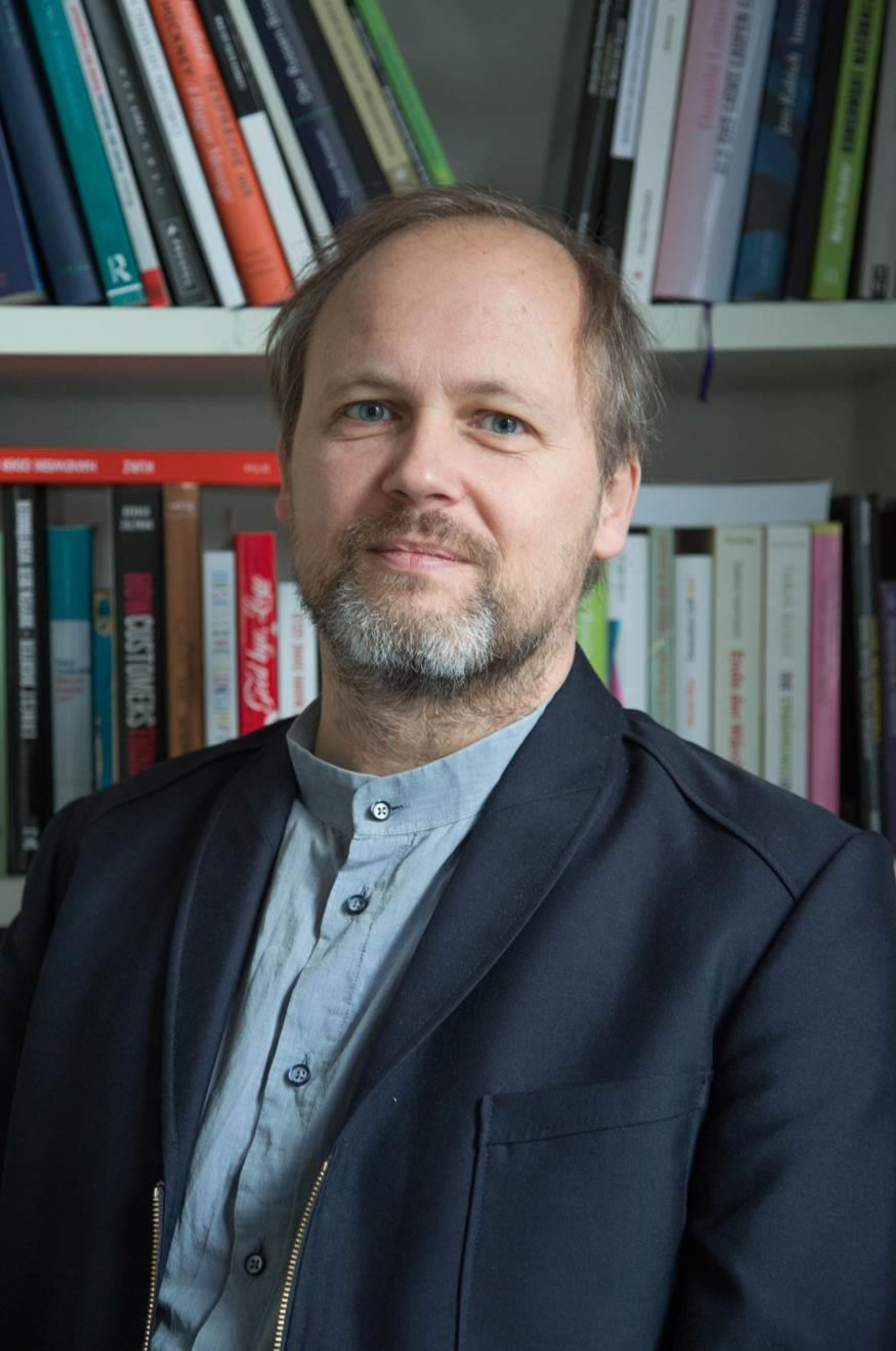
Using Children to Play Power Politics
In the past, powerful figures and rulers would have themselves portrayed surrounded by their family in painting after painting. Nowadays, politicians in Germany tend to refrain from publishing private pictures. This is in contrast to the USA and Canada, where powerful people use family photos for entirely political purposes – as the art historian Dr. Wolfgang Ullrich observes.
Historically, children often played a central role in the political iconography of monarchies. To create general symbols of the future, while at the same time communicating a promise of continuity and stability, rulers would have themselves portrayed with their own children. An example of this is the painting entitled “The Imperial Family in the Park of Sanssouci” (1891), which can be seen in the Deutsches Historisches Museum’s permanent exhibition. Painted by William Pape, this picture portrays Kaiser Wilhelm II, his wife Auguste Viktoria, and five of their children. It is the latter who occupy the foreground, their considerable number allaying any doubts about whether there would be a suitable heir to the throne. At the same time, the painting follows aristocratic logic, which stipulates that it is not only important to secure the future, but equally vital to give certainty to family origins. Therefore in the background, in a position corresponding to the children, there is an equestrian statue of Frederick the Great – the most famous forebear of the House of Hohenzollern. This Kaiser’s power is thus given twofold legitimacy. To put it in crude terms: he has the best genes, and is sufficiently virile to pass them on.
However, similar iconography is also to be found in democracies. Here, dynastic thinking has by no means disappeared; instead, in many countries there are examples of families who over the course of generations hold (or at least seek to hold) positions of power. At present there is barely any other politician who makes more prolific use of his family than the US president, Donald Trump. He confers semi-official functions to family members, even allows his daughter Ivanka to stand in for him briefly at conferences, and repeatedly underlines how he prioritizes family relationships above all others. It is hardly surprising, therefore, that this has resulted in images reminiscent of Pape’s portrait of Kaiser Wilhelm and his family. When, for example, Trump and his family visited the Lincoln Memorial in Washington D.C. in January 2017 as part of the presidential inauguration, the photograph was similarly arranged so that his children and grandchildren occupied the foreground. The intended message is that, while his presidency may well end in four (or eight) years, this by no means need signal the end of the Trump dynasty. The picture’s background, however, pits dynastic thinking against its antithesis: with the figure of Lincoln behind him rather than one of his own ancestors, Trump is forced to relate his own person to that of one of his most important predecessors. It is not genes, therefore, but democratic elections that decide who becomes president of the United States.
https://www.instagram.com/p/BPdz5a0A5u7/
Nevertheless, the years since the era of monarchic and aristocratic rule have witnessed an increase both in the number and effectiveness of opportunities for politicians to use their own children as a way of courting public sympathy, though while simultaneously underpinning their dynastic claim to power. Increasingly, social media has been used for this purpose; in particular, Instagram has proven an effective platform for constructing a particular image. A significant reason for this is that Instagram often shows what appear to be people’s private lives, thus giving you the impression of being privy to something that would otherwise be exclusive – as a follower, you feel privileged and better informed than other people. Accordingly, this special knowledge is more appreciated, taken more seriously, and perceived as being more authentic.
The Trump family in particular is one of the first among political families to take systematically to Instagram in order to prove its special status. It is not just Trump himself and his wife, but also his sons and daughters (as well as some of their spouses) who have Instagram accounts, which they use on a daily basis to report on their lives, document their personal lifestyle – and, especially, show off their children. The cute faces of kids can distract from the often aggressive nature of Trump’s politics (for this reason, large numbers of this type of picture appear each time there is yet another particularly controversial political turn of events); at the same time, the numerous photos of children highlight how the president is part of a large family that enjoys an entirely self-evident stake in his power. Thus you can see children in the White House, even playing in the Oval Office, in a way suggesting that it is a completely normal living room. In contrast to the era of court paintings, a claim to power does not even have to be limited to a small number of paintings with particularly concentrated iconographical representations. Instead, it can be distributed in small doses across a variety of photographs and social-media accounts. Consequently, photographs apparently taken from private photo albums possess an unprecedented political dimension.
https://www.instagram.com/p/BQngOAIlSOX/
https://www.instagram.com/p/BPto1qmAq9r/
https://www.instagram.com/p/BSmhDSajlai/
The Canadian Prime Minister Justin Trudeau also uses Instagram, and so lends a political dimension to his own private life as well. Himself the son of a former prime minister, Trudeau shows his children doing their homework in his office, or even on one occasion sitting down at dad’s seat in cabinet. As much as these pictures serve to construct an image of the children as natural successors, associating them with political ambitions, at the same time they allow Trudeau to appear not only as prime minister, but also as an equally committed father. In so doing, he is also following a tradition established by his father, who previously employed the same strategy. However, Trudeau Junior presents himself more consistently as a new type of politician who, in spite of all the obligations of office, always has time for his children. Work-life balance thus functions here as the ideal standard, as demonstrated in a photo posted on Fathers’ Day, showing Trudeau and two of his children sitting happily together on a sofa. Hence the politician not only defines himself by his office, but also derives just as much meaning in his life from his role as a family man and father. The aim is to make him look as though he is free of hunger for power: as a good democrat, he knows that he is only elected for a period of time, and therefore cannot define himself purely by reference to his political office.
https://www.instagram.com/p/BLvzI7ZAp6e/
https://www.instagram.com/p/BNw53eIBKOa/
https://www.instagram.com/p/BT7nYH1BrKG/
https://www.instagram.com/p/BVe4D1lBqTK/
While the staging of Trudeau’s pictures is testament to how children can be used to articulate both a dynastic and democratic understanding of political office, in Europe – and particularly in Germany – a different set of circumstances prevail. Here it has become a strict rule over the course of recent decades that children are left completely out of political iconography. It is considered to be an offense against personal rights to make subjects of this kind out of children who, having not reached legal majority, are unable to make decisions for themselves or assess the consequences of the photographs. Even (and particularly) politicians who, like Trudeau, see themselves as mothers and fathers will only make at most indirect use of platforms such as Instagram in order to show the extent to which parenthood shapes their lives. For example, the CSU politician and state finance secretary Dorothee Bär often styles herself with the hashtag #momofthree, and so demonstrates her pride at having given birth to three children while pursuing her political career. However, when she gives news of something like a child’s birthday, you only see toys and sweets – but never the children. On the occasions when children do make an appearance in the picture, their faces are always concealed.
https://www.instagram.com/p/BXAqFMBF3-h/
For this reason, many people felt that a taboo had been broken when Frauke Petry, the leader of the AfD (the far-right “Alternative für Deutschland” party), circulated a poster for the 2017 parliamentary election. Here she is seen with her youngest child – her son Ferdinand, born only in May of this year. Moreover, the child is not seen from behind, but photographed in a way that makes him easily recognizable. The message (supported by the text on the poster) is clear: people who are parents will act all the more passionately and responsibly to ensure the best possible future for their children. At the same time, however, Petry deploys allegations popular both among her own supporters and with other groups on the political right/far-right. These claim that Europe’s identity and traditions are put in danger because the continent is overwhelmingly governed by politicians who themselves have no children: Angela Merkel, Emmanuel Macron, Theresa May. Furthermore, Petry’s baby also fulfils a function similar to that of the children portrayed in William Pape’s painting: the infant’s presence serves to prove that the future and continuity is assured if people have enough children of their own.

© Annekathrin Kohout |
Dr. Wolfgang UllrichWolfgang Ullrich, born 1967, lives in Leipzig and is a freelance author. Previously he worked as Professor for Science of Art and Media Theory at the Staatliche Hochschule für Gestaltung in Karlsruhe. Ullrich researches and writes about the history and criticism of the concept of art, visual-sociological questions and consumption theory. For more information see: www.ideenfreiheit.de. |